It’s one thing to be among the 63% of service and support leaders who count improving their operations among their top priorities. It’s another thing to be a service and support leader that understands why. Is it contact center optimization for cost, for elevating the experience for customers, or both?
Even the world’s most recognized brands struggle to understand the why behind their contact center optimization, and it shows. You can usually spot the issue with a quick test. For example, visit any healthcare or finance company online and compare two journeys:
- How easy it is to buy
- How easy it is to find help
Or better yet, hop on G2.com or TrustRadius and read some reviews. You’ll find plenty of people who’ve encountered brands that bury their Contact Us
This creates significant challenges for contact centers.
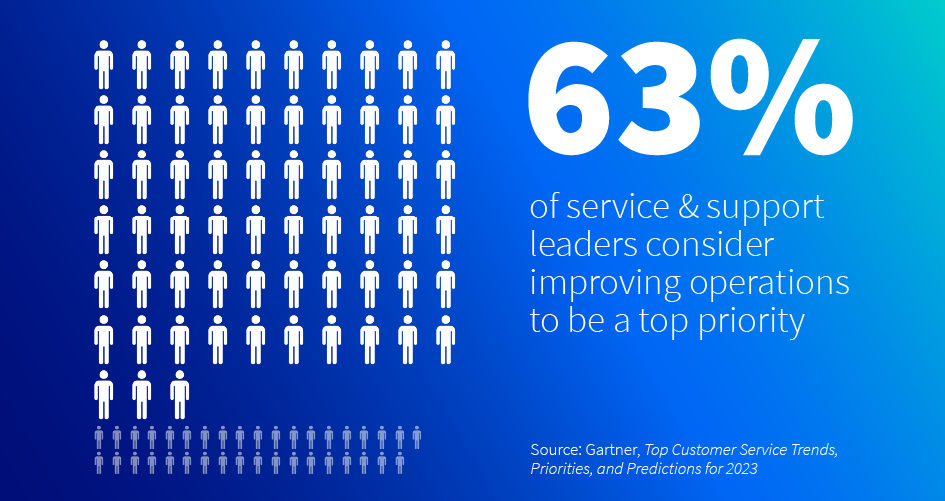
Why contact center optimization remains a challenge for customer service leaders
It’s challenging to reach optimal performance across all key service metrics while still delivering stellar experiences for customers and agents. Four issues tend to stand in the way:
1. A lack Of organizational alignment and buy-in
One of the common complaints we hear about multichannel contact center models is lack of alignment. The cause is almost always organizational silos, in which different teams focus solely on their channels, with little emphasis on cohesion with the efforts, goals, and key metrics of other teams.
Take case origination, for example.
Scenario: product and support misalign, create case spike
Let’s say the contact center is wondering why they’re experiencing an unexpected spike in cases related to “where’s my license number.” In an organization with poor alignment and visibility, that scenario might play out like this:
- Cases spike unexpectedly for “where’s my license number”
- The contact center team reviews a representative sample of cases to investigate the root cause
- The team discovers that product made a slight change to the settings menu that’s causing the spike in cases
If the product team and contact center were more aligned on product releases and updates, this case spike could have been avoided.
Scenario: a skeptical VP quashes new contact center initiative
In some cases, the lack of alignment comes in the form of no buy-in at the executive level. A VP of Customer Service might not sign off on implementing a cloud contact center solution, for example, because they still view contact centers as cost centers rather than a critical component of the customer experience.
Overcoming a lack of executive buy-in for efforts to optimize the contact center requires a few ingredients:
- A clear picture of the benefits of contact center optimization in terms of cost savings, increased customer satisfaction, and improved operational efficiency
- Data-driven evidence and case studies from other companies can help illustrate the potential ROI
- Involvement of stakeholders throughout the decision-making progress
- Ongoing communication, monitoring, and reporting
2. New external changes and challenges
That enterprises now compete on customer experience puts even more pressure on contact centers to adapt. There’s more competition for that experience, more choice for customers, and a proliferation of digital service channels.
The external landscape is constantly changing.
As a result, it’s easier than ever for brands to quickly develop a reputation for inadequate customer service. Even when an enterprise wants to accelerate contact center optimization, it can find itself behind the ball.
Take COVID-19, for example. At the height of the pandemic, contact centers were inundated with change. The massive and rapid move to remote and hybrid working environments comes to mind, as does the quick and widespread adoption of digital channels. Contact centers were forced to adapt, part of the reason why, for example, the adoption of CCaaS solutions increased in Europe and the U.K.
3. A struggle to use contact center optimization data effectively
According to a recent report by Aberdeen, most contact centers struggle to use data effectively to optimize their customer experiences. They’re inundated with useful customer data but lack the tools and processes to effectively analyze and take action.
Many may miss critical insights into customer behavior, preferences, and pain points that could inform their contact center optimization strategies. For example, they may collect feedback through surveys or social media but not have a system in place to analyze that feedback and take action based on it.
Not good: 62% of customers expect a response within 30 minutes when they contact customer service via social media.
Additionally, many contact centers may lack a comprehensive dashboard view of their data. Instead, information is siloed across different systems and departments, which ties in to challenge #1 (lack of organizational alignment). This can make it difficult to create cohesive and actionable contact center strategies for improving the customer experience. That goes for contact center workforce optimization, too.
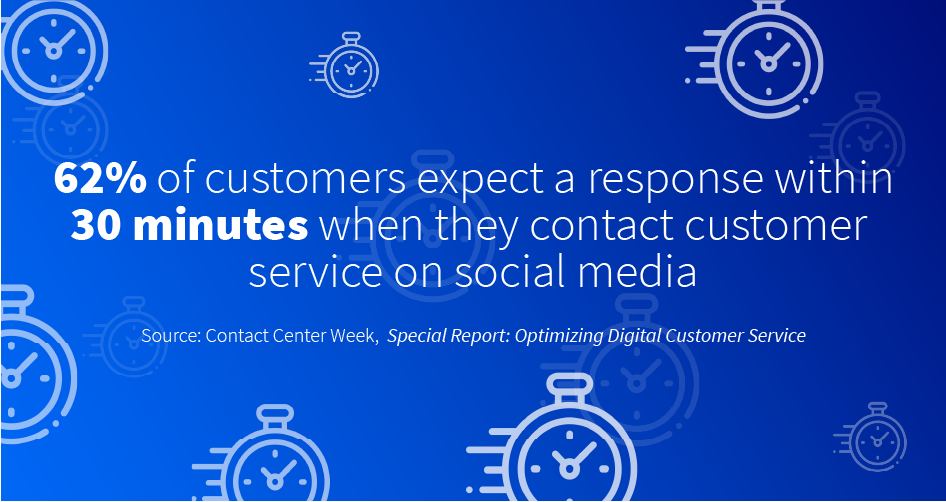
4. Reliance on legacy systems
Contact center optimization will be a far steeper hill for teams relying on legacy technology. According to a special report from Customer Contact Week, 78% of organizations say that their contact center technology is outdated and not meeting their current needs. And though 84% of organizations believe that customer experience is a competitive differentiator, only 28% say that their contact center technology is helping them deliver an excellent customer experience.
The good news is that the same report found that more than half of contact center teams plan to move their contact center technology to the cloud within the next 12-18 months. Why? Because cloud-based contact center optimization software has a few advantages:
More flexibility and scalability
You can scale cloud contact center systems up or down based on changing business needs. This capability is particularly useful to ensure business continuity during case spikes, for example, and managing staffing and resources.
Better access to useful data
On-premises contact center systems can make it difficult for contact centers to access and analyze customer data. With a cloud-based system, you can track customer interactions across multiple channels for a more comprehensive view of the customer journey.
Lower maintenance and support costs
On-premises contact center systems are famously expensive to maintain and support, including IT staff and infrastructure. These costs are significantly less for cloud-based systems.
Limited remote work capabilities
Cloud-based contact center systems are better suited for remote or hybrid work arrangements.
What is contact center optimization? Three critical focus areas
We recommend focusing on three areas to make sure your contact center operations go beyond transactional touchpoints to become a brand-building experience.
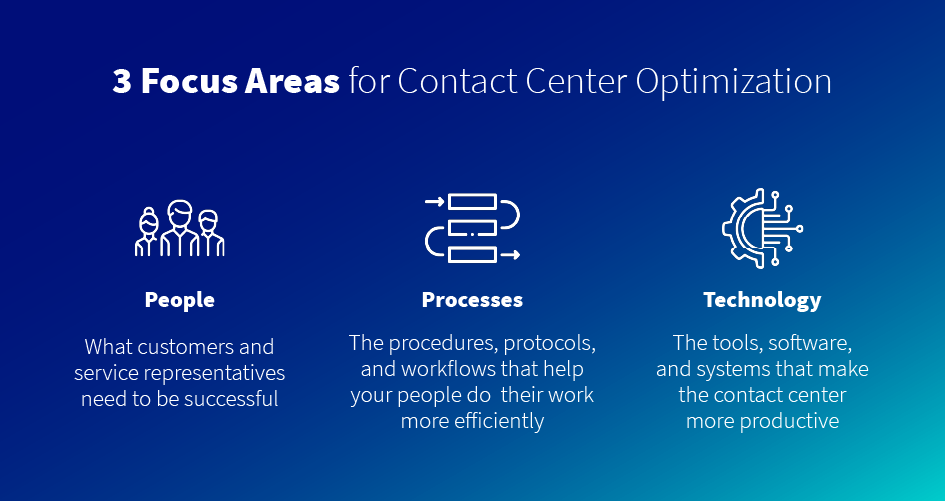
The people you and your customers rely on
By some estimates, 55 to 65 percent of a contact center’s budget comprises “people-related expenses.” To optimize for your people, first think about what people do and don’t want.
We know for certain that customers don’t want to wait a long time for help. They don’t want to repeat themselves as they move from channel to channel, either. Customers do want to interact with informed, proactive, and empathetic support agents. And they do expect to switch between support channels seamlessly.
To meet these customer expectations means optimizing for your internal people, too. For instance, are your teams organized and equipped for optimal contact center performance? Has your organization formalized a framework for aligning different teams and created an environment that supports collaboration, transparency, and communication?
Because you need to account for more than customer expectations. For instance, 81% of service professionals say that they prefer to handle complex issues over the phone—up from 76% since 2020.
Writing for Tech Target, Robert Azman recommends linking “employee engagement to the customer experience” and aligning “skill sets, rewards, and recognition programs and career pathing.” Here are a few high-level means for doing so:
- Support, coaching, training, and tools
- Well-defined roles, responsibilities, and accountability
- Corporate culture building
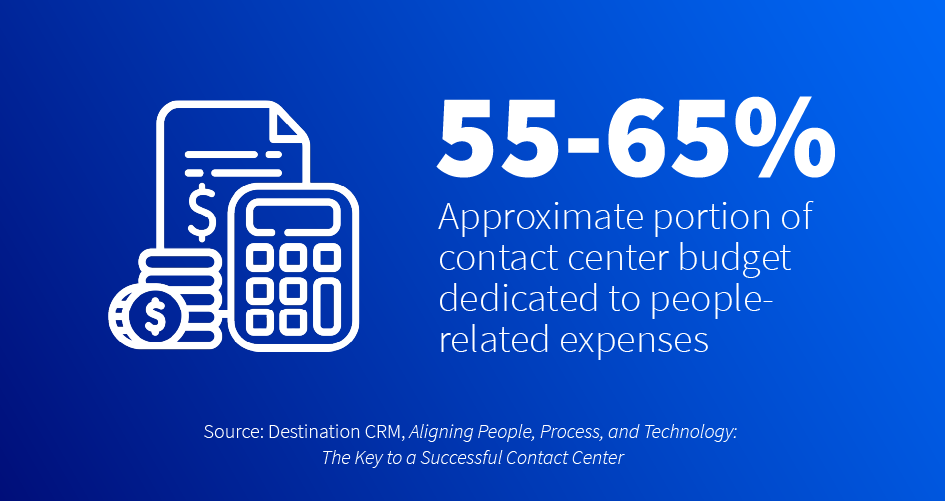
The processes in place to support customers and team members
Optimize your contact center processes to help people do their work better. Start by updating the outdated processes that tend to frustrate agents and lead to churn. These include:
- Asking call center agents to switch between multiple systems to perform a single task
- Failing to integrate an up-to-date, comprehensive knowledge base into the agent workflow
- Undervaluing self-service options as a means for easing pressure on frontline support tiers
- Providing inadequate support and infrastructure for hybrid and remote working environments
These are just a few examples of high-level processes that often require attention in the contact center. As part of their contact center optimizations, many teams will begin with a comprehensive process audit, in which they take inventory of the core processes that both agents and customers rely on.
Ultimately, you want to create a contact center where agents actually want to work—where they feel like the system is designed to help them succeed. This ought to include a clear understanding of how your contact center measures and defines success, both on the agent level and as an organizational unit.
The technology you use to serve customers in the contact center
Finally, optimize your contact center technology to help to make the system more efficient, faster, and more cost-effective. A cursory look at the landscape reveals the urgent need to optimize contact center technology. Consider this:
- 48% of contact centers struggle to integrate new technologies with existing systems and processes (Frost & Sullivan survey)
- 84% of organizations believe that customer experience is a competitive differentiator, but only 28% say that their contact center technology is helping them deliver on those customer expectations (Contact Center Weekly)
Your own tech stack likely includes customer relationship management (CRM), a communications system (phone, email, chat), and analytics. Some enterprise contact centers also rely on enterprise resource planning (ERP) and workforce optimization (WFO), in some capacity. Finally, you’re likely to use some form of knowledge management system and, perhaps, enterprise search to stitch it all together.
All of these systems must be audited and optimized to deliver the best experience, including how they integrate with each other. Many contact center professionals are turning to artificial intelligence (AI) to help streamline various aspects of contact center operations. We cover more on AI in the contact center here: AI for Customer Experience: 5 Use Cases for the Modern Contact Center.
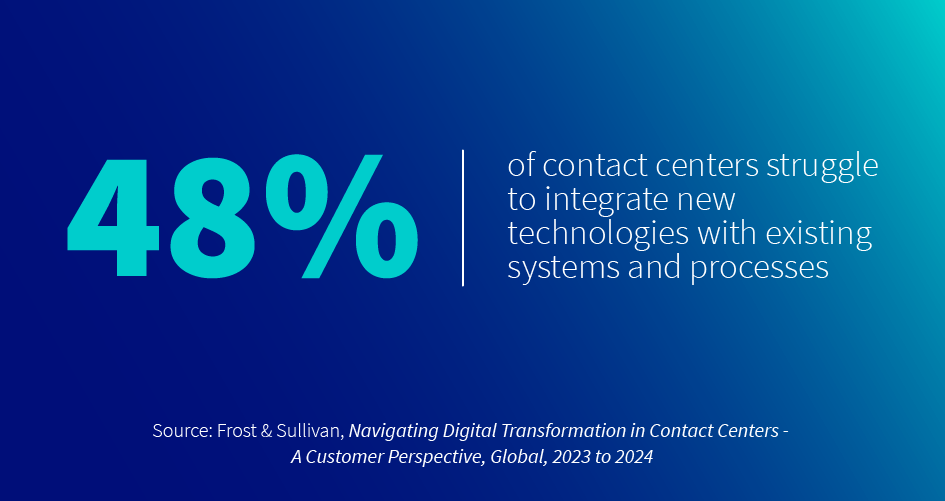
Spotlight: Call center optimization
Let’s take a closer look at the call center optimization model, in particular. You might be familiar with Interactive Voice Response System (IVR), IVR Self-Service and Automatic Call Distributor (ACD) technology, but only 46% of companies support a Virtual Assistant Voice channel today. A little over half (54%) support IVR.
These technologies open up a lot of opportunities for call center optimization, especially for call and case routing, as illustrated by the following case study.
Case Study: Healthcare Giant Undergoes Customer-Centric Optimization
TrialCard is a representative example of call center optimization. With the help of Bucher + Suter, the healthcare company was able to lower hold times, fewer customer transfers, and faster problem resolution. In the end, TrialCard cut the average speed of answer by 95%.
See how they did it: Using the Power of Technology to Optimize Customer Engagement
Spotlight: Omnichannel
70% of customers say that they expect a seamless experience when moving between different channels of customer service. For a complete look at omnichannel in the contact center, see: Why the World’s Top Enterprises Invest in an Omnichannel Contact Center.
Spotlight: Automation
Any contact center optimization plan ought to include some automation strategies. Indeed, 67% of customer service professionals believe that automation will play a major role in the future of customer service. What’s more, companies that prioritize customer experience automation see a 3.4 times greater increase in customer satisfaction rates compared to companies that don’t prioritize automation.
The question is, where to begin? Many contact centers will deploy chatbots to automate low-touch, high-volume cases. Certain call routing solutions can be used for the same purpose, as can self-service automation through effective communities, help search experiences, and support portals.
Why contact center optimization remains a sound investment
There’s ample evidence to suggest that more investment is shifting toward the contact center. The question is, what’s the potential business upside of doing so?
Plenty, at least according to the aforementioned special report from Contact Center Weekly (Optimizing Digital Customer Service, already cited above). Indeed, companies that excel at omnichannel customer engagement see a 9.5% year-over-year increase in annual revenue, compared to 3.4% for companies with poor omnichannel engagement.
Separately, companies that use AI-powered chatbots for customer service can reduce customer service costs by up to 30%. And 75% of customers say they are more likely to do business with a company offering chatbots and self-service options.
The business case is there.
Case study: Republic Services invests in contact center optimization
Republic Services fields some 12,000,000 calls a year. They also employ approximately 1,200 call center agents across 100 different locations. To say that dropped calls, extended agent response times, and other inefficiencies are costly to Republic Services is an understatement.
The Republic Services team worked with Bucher + Suter to optimize their contact center for faster time to resolution, lower wait times, and happier, more productive agents. The result? An annual return-on-investment of well over $500,000 per year and a significant boost to customer satisfaction.
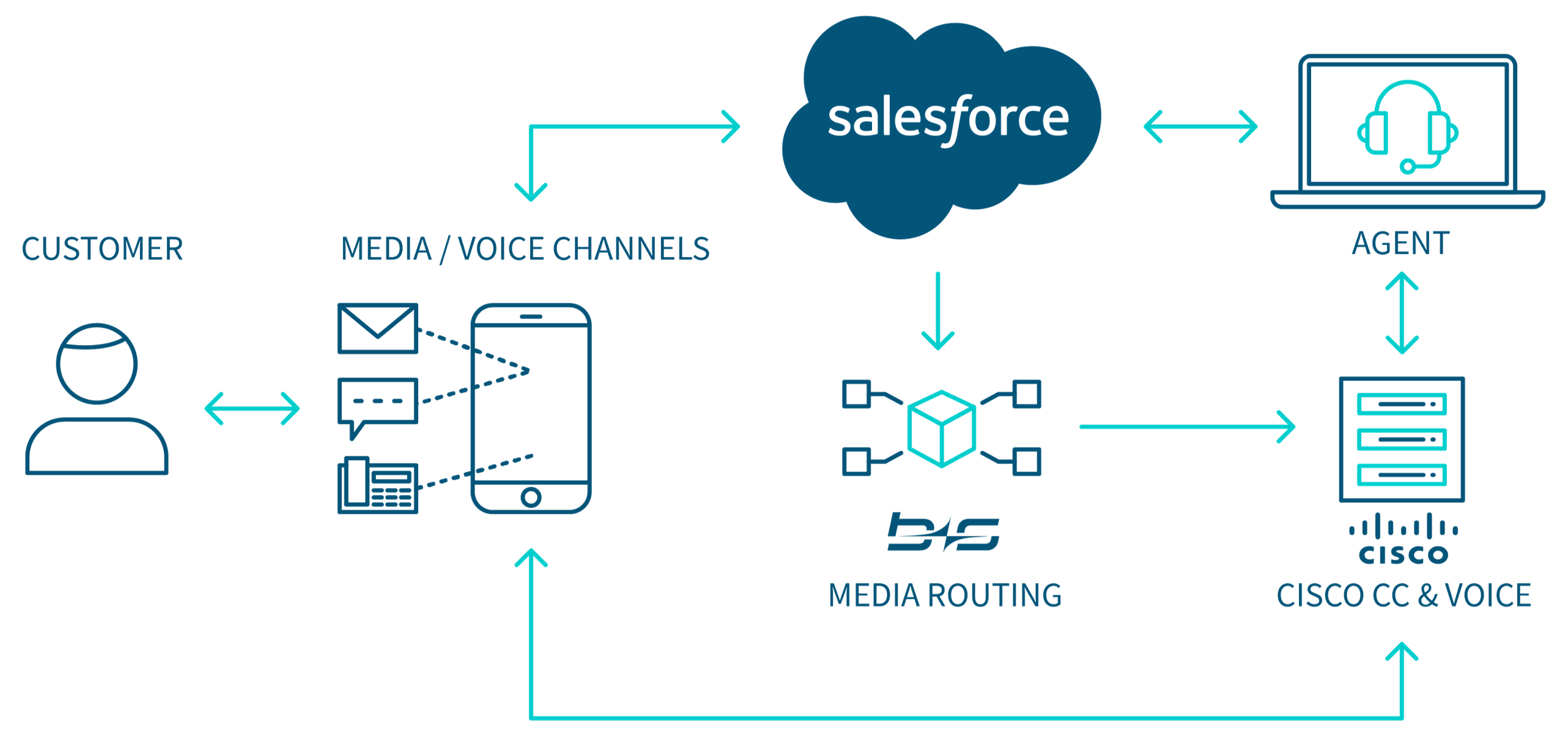
Read the case study: Republic Services with b+s Connects for Salesforce.
Adapt and evolve in the name of customer experience
People. Processes. Technology. Hardly a new model for optimization, but one that continues to serve the contact center well. And one that continues to evolve, forcing contact center teams to continuously adapt.
Overall, the data indicates a prevailing shift toward prioritizing the contact center. But it can’t stop there, and it can’t only be about efficiency and cost. The very best enterprise contact centers start with the customer relationship before anything else. They consider customer satisfaction to be their north star.
You’ll find that doing that same inevitably leads to new opportunities for optimization in the agent experience, reporting and analytics, and beyond.
If you’d like to understand more about Bucher + Suter’s contact center and call center optimization services, then please contact us using the form below.





